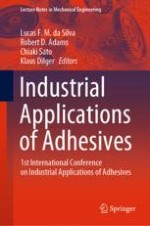2021 | Buch
Industrial Applications of Adhesives
1st International Conference on Industrial Applications of Adhesives
herausgegeben von: Prof. Dr. Lucas F. M. da Silva, Prof. Robert D. Adams, Chiaki Sato, Prof. Dr. Klaus Dilger
Verlag: Springer Singapore
Buchreihe : Lecture Notes in Mechanical Engineering
